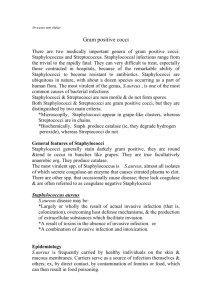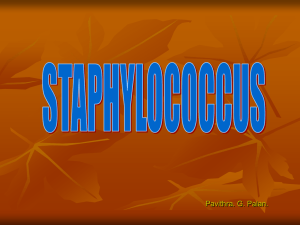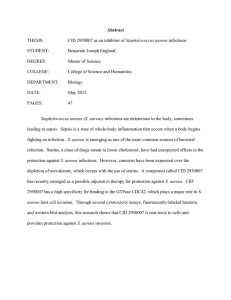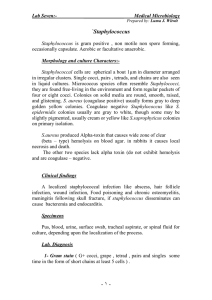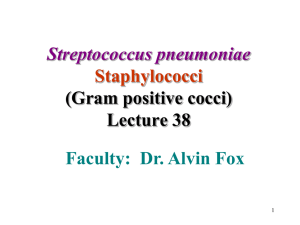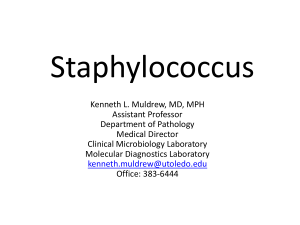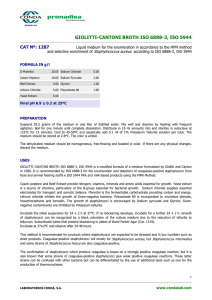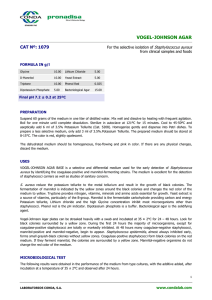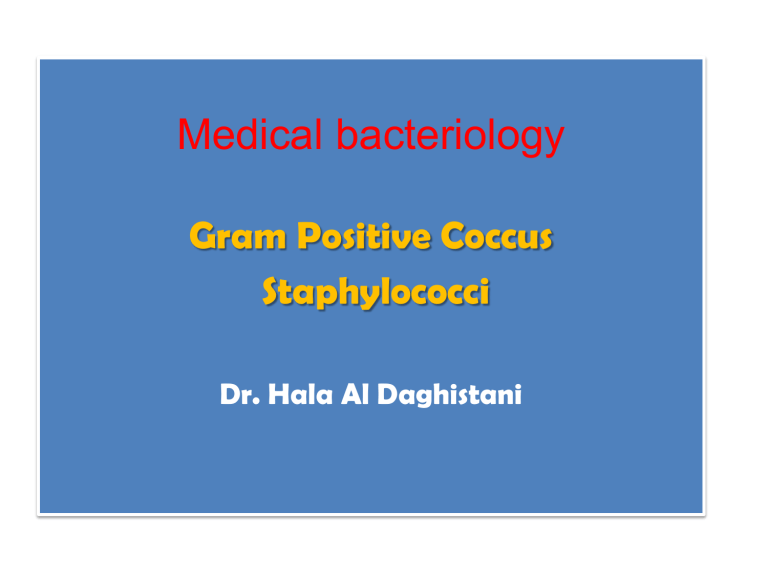
Medical bacteriology Gram Positive Coccus Staphylococci Dr. Hala Al Daghistani The Staphylococci are gram-positive spherical cells, nonmotile, usually arranged in grapelike irregular clusters. Some are members of the normal microbiota of the skin and mucous membranes of humans; others cause suppuration, abscess formation, a variety of pyogenic infections, and even fatal septicemia. The genus Staphylococcus has at least 40 species. The four most frequently encountered species of clinical importance are Staphylococcus aureus Staphylococcus epidermidis Staphylococcus saprophyticus. •S. aureus is coagulase positive , which differentiates it from the other species. S aureus is a major pathogen for humans. •The coagulase-negative staphylococci are normal human microbiota and sometimes cause infection •Approximately 75% of the infections caused by coagulasenegative staphylococci are caused by S. epidermidis •S. saprophyticus is a relatively common cause of urinary tract infections in young women. Antigenic Structure Staphylococci contain antigenic polysaccharides (Piptidoglycan) and proteins. Piptidoglycan • Elicits production of interleukin-1 (endogenous pyrogen) •Opsonic antibodies by monocytes •It can be a chemoattractant for PMN leukocytes •Have endotoxin-like activity •Activate complement. Teichoic acids, can be antigenic. Protein A is a cell wall component of S aureus strains and is a bacterial surface protein that has been characterized among a group of adhesions. . Protein A binds to the Fc portion of IgG molecules except IgG3. Most S. aureus strains of clinical importance have polysaccharide capsules, which inhibit phagocytosis . At least 11 serotypes have been identified, with types 5 and 8 responsible for the majority of infections. Enzymes and Toxins A. Catalase: Staphylococci produce catalase, which converts hydrogen peroxide into water and oxygen. B. Coagulase: S aureus produces Coagulase, an enzymelike protein that clots plasma. Coagulase may deposit fibrin on the surface of staphylococci, perhaps altering their ingestion by phagocytic cells or their destruction within such cells C. Other Enzymes Other enzymes produced by staphylococci include a hyaluronidase, or spreading factor; a staphylokinase resulting in fibrinolysis; proteinases; lipases; and -lactamase. D. Hemolysins • a-Hemolysin acts on eukaryotic cell membranes. •β-Hemolysin degrades sphingomyelin and therefore is toxic for many kinds of cells, including human red blood cells. • δ- Hemolysin disrupts biologic membranes and may have a role in S aureus diarrheal diseases. • γ-Hemolysin is a leukocidin that lyses white blood cells E. Panton-Valentine Leukocidin •This toxin of S aureus has two components , kill white blood cells of humans and rabbits. F. Exfoliative toxins These epidermolytic toxins of S aureus are two distinct proteins of the same molecular weight. Exfoliative toxin A is encoded by eta and exfoliative toxin B encoded by etb these epidermolytic toxins yield the generalized desquamation of the staphylococcal scalded skin syndrome by dissolving the mucopolysaccharide matrix of the epidermis. The toxins are superantigens. G. Toxic shock syndrome toxin most S aureus strains isolated from patients with toxic shock syndrome produce a toxin called toxic shock syndrome toxin-1 (TSST-1), superantigen The toxin is associated with fever, shock, and multisystem involvement, including a desquamative skin and rash. H. Enterotoxins There are multiple (19) enterotoxins that are superantigens. The enterotoxins are heat stable and resistant to the action of gut enzymes. Important causes of food poisoning, ingestion of 25 µg of enterotoxin B results in vomiting and diarrhea. The emetic effect of enterotoxin is probably the result of central nervous system stimulation (vomiting center) after the toxin acts on neural receptors in the gut. PATHOGENESIS Staphylococci, particularly S epidermidis, are members of the normal microbiota of the human skin and respiratory and gastrointestinal tracts. Nasal carriage of S aureus occurs in 20–50% of humans. Pathology: Staphylococcal lesion includes: furuncle or other localized abscess. Groups of S aureus established in a hair follicle lead to tissue necrosis (dermonecrotic factor). From any one focus, organisms may spread via the lymphatics and bloodstream to other parts of the body. In Osteomyelitis, the primary focus of S aureus growth is typically in a terminal blood vessel of the long bone, leading to necrosis of bone and chronic suppuration. S aureus may cause pneumonia, meningitis, empyema, endocarditis, or sepsis with suppuration in any organ. Staphylococci are involved in many skin infections (e.g, acne, pyoderma, or impetigo). Scalded skin syndrome, is caused by the production of exfoliative toxins. Toxic shock syndrome is associated with TSST-1. Toxic shock syndrome is manifested by an abrupt onset of high fever, vomiting, diarrhea, myalgias, a scarlatiniform rash, and hypotension with cardiac and renal failure in the most severe cases. It often occurs within 5 days after the onset of menses in young women who use tampons, but it also occurs in children and men with staphylococcal wound infections Food poisoning caused by staphylococcal enterotoxin is characterized by a short incubation period (1–8 hours); nausea, vomiting, and diarrhea; and rapid convalescence. There is no fever. DIAGNOSTIC LABORATORY TESTS A. SPECIMENS Surface swab pus or aspirate from an abscess, blood, tracheal aspirate, or spinal fluid for culture, depending on the localization of the process, are all appropriate specimens for testing. B. CULTURE MEDIA Specimens planted on blood agar plates , MSA. . D. BIOCHEMICAL TESTS: Catalase test, coagulase test E. SUSCEPTIBILITY TESTING AND ANTIBIOTICS (until relatively recently, MRSA was confined primarily to the hospital setting).
